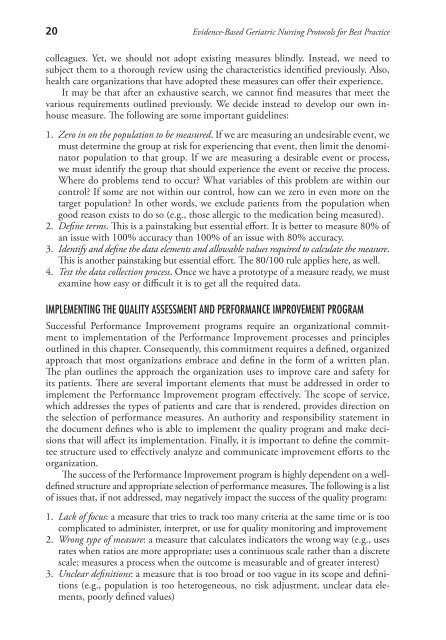Evidence-Based Geriatric Nursing - Springer Publishing
Evidence-Based Geriatric Nursing - Springer Publishing
Evidence-Based Geriatric Nursing - Springer Publishing
Create successful ePaper yourself
Turn your PDF publications into a flip-book with our unique Google optimized e-Paper software.
20<br />
<strong>Evidence</strong>-<strong>Based</strong> <strong>Geriatric</strong> <strong>Nursing</strong> Protocols for Best Practice<br />
colleagues. Yet, we should not adopt existing measures blindly. Instead, we need to<br />
subject them to a thorough review using the characteristics identified previously. Also,<br />
health care organizations that have adopted these measures can offer their experience.<br />
It may be that after an exhaustive search, we cannot find measures that meet the<br />
various requirements outlined previously. We decide instead to develop our own inhouse<br />
measure. The following are some important guidelines:<br />
1. Zero in on the population to be measured. If we are measuring an undesirable event, we<br />
must determine the group at risk for experiencing that event, then limit the denominator<br />
population to that group. If we are measuring a desirable event or process,<br />
we must identify the group that should experience the event or receive the process.<br />
Where do problems tend to occur? What variables of this problem are within our<br />
control? If some are not within our control, how can we zero in even more on the<br />
target population? In other words, we exclude patients from the population when<br />
good reason exists to do so (e.g., those allergic to the medication being measured).<br />
2. Define terms. This is a painstaking but essential effort. It is better to measure 80% of<br />
an issue with 100% accuracy than 100% of an issue with 80% accuracy.<br />
3. Identify and define the data elements and allowable values required to calculate the measure.<br />
This is another painstaking but essential effort. The 80/100 rule applies here, as well.<br />
4. Test the data collection process. Once we have a prototype of a measure ready, we must<br />
examine how easy or difficult it is to get all the required data.<br />
IMPLEMENTING THE QUALITY ASSESSMENT AND PERFORMANCE IMPROVEMENT PROGRAM<br />
Successful Performance Improvement programs require an organizational commitment<br />
to implementation of the Performance Improvement processes and principles<br />
outlined in this chapter. Consequently, this commitment requires a defined, organized<br />
approach that most organizations embrace and define in the form of a written plan.<br />
The plan outlines the approach the organization uses to improve care and safety for<br />
its patients. There are several important elements that must be addressed in order to<br />
implement the Performance Improvement program effectively. The scope of service,<br />
which addresses the types of patients and care that is rendered, provides direction on<br />
the selection of performance measures. An authority and responsibility statement in<br />
the document defines who is able to implement the quality program and make decisions<br />
that will affect its implementation. Finally, it is important to define the committee<br />
structure used to effectively analyze and communicate improvement efforts to the<br />
organization.<br />
The success of the Performance Improvement program is highly dependent on a welldefined<br />
structure and appropriate selection of performance measures. The following is a list<br />
of issues that, if not addressed, may negatively impact the success of the quality program:<br />
1. Lack of focus: a measure that tries to track too many criteria at the same time or is too<br />
complicated to administer, interpret, or use for quality monitoring and improvement<br />
2. Wrong type of measure: a measure that calculates indicators the wrong way (e.g., uses<br />
rates when ratios are more appropriate; uses a continuous scale rather than a discrete<br />
scale; measures a process when the outcome is measurable and of greater interest)<br />
3. Unclear definitions: a measure that is too broad or too vague in its scope and definitions<br />
(e.g., population is too heterogeneous, no risk adjustment, unclear data elements,<br />
poorly defined values)

















